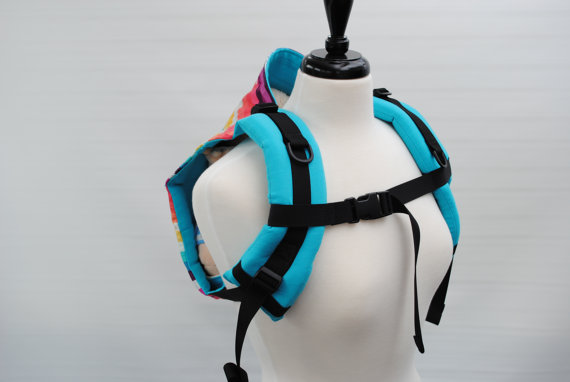Description
A rectangular body panel with padded backpack-like straps and webbing attaching each top corner to the bottom corner on the same side. A chest clip attaches the two shoulder straps together. The straps may have a buckle-closure or be permanently closed with ladder-lock adjustment.
Buckle Onbuhimos are modeled off of the traditional Japanese Onbuhimo, which secures with shoulder straps threaded through loops or rings at the bottom corners of the body panel.
Sometimes referred to as a "
bucklebu," although this term does not give proper respect to the original heritage and language and is best avoided.
Good For
- Front Carries: Depends on the design, but not typically designed for front carries. Possible with babies with decent trunk control, especially if the carrier allows the straps to cross in the back.
- Hip Carries: Not designed for hip carries.
- Back Carries: Babies who can sit independently only. Especially great for walkers.
- Forward Facing: Not designed for forward facing.
Advantages
Quick to put on and an unpoppable seat makes it easier to wear wiggly or difficult toddlers who may not have the patience for wrapping. Lack of waist belt is great for anybody who doesn't want the pressure on their waist, including (but not limited to) expectant mothers. Lack of waist belt and tie offs makes them great for tandem-wearing, since there is nothing to interfere with the front baby.
Disadvantages
More limited than other carriers, since onbus are really best for older, independently sitting babies and only designed for back carries. Panel size is dependent on child's size. Therefore a parent who chooses to wear as their baby reaches toddlerhood or preschooler age may need to upgrade to a toddler-size or preschool-size carrier. Puts all the weight high and on the shoulders, which can be difficult for some wearers.
Variations
- Ladder lock straps: Instead of buckling closed, a buckle-bu with ladder lock closure is permanently "closed" and simply tightens or loosens with ladder locks like a back pack.
Sizing
Body panel size is based on child's size. Baby needs to be able to fit in the carrier arms-out, but the panel must not be so low that baby can lean backwards. It is recommended that the panel come up to at least "bra strap height" on baby's back. The width should be wide enough to support baby's legs from knee-pit to knee-pit, while still allowing the legs to swing freely at the knee, although slightly too narrow is safer than too wide. The shoulder strap lengths are flexible, but determined by wearer's size.
How to Use






